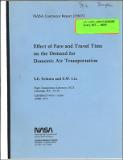| dc.contributor.author | Eriksen, Steven Edward | en_US |
| dc.contributor.author | Liu, Elliott Wu-Hsun. | en_US |
| dc.contributor.other | Massachusetts Institute of Technology. Flight Transportation Laboratory | en_US |
| dc.contributor.other | United States. National Aeronautics and Space Administration | en_US |
| dc.contributor.other | Langley Research Center. | en_US |
| dc.date.accessioned | 2012-01-06T06:51:53Z | |
| dc.date.available | 2012-01-06T06:51:53Z | |
| dc.date.issued | 1979 | en_US |
| dc.identifier | 05808912 | en_US |
| dc.identifier.uri | http://hdl.handle.net/1721.1/67965 | |
| dc.description | April 1979 | en_US |
| dc.description | Includes bibliographical references (p. 80) | en_US |
| dc.description.abstract | Introduction: One of the axioms in the air transportation industry is that advances in technology have led to a greater amount of passenger travel by air. Improvements in airframe and engine design have increased range, speed and payload and have decreased seat-mile costs (in constant dollars), while simultaneously introducing more comfortable and safer travel. The resultant lower ticket prices have made pleasure travel steadily more attractive in the competition for the consumer's disposable income, while the availability of comfortable, high speed travel has increased the air mode's share of business travel. However, it has not been a trivial matter to determine the magnitude of travel that can be attributed to advanced aircraft technology. NASA, as the U.S. government agency responsible for research and technology in commercial aviation, has a natural interest in the applications of the technological improvements it has helped to create. Thus NASA has sponsored research analyzing the economic and operational impact of technological innovations; some of these studies have attempted to quantify the demand for air transportation that improvements in technology have brought about. This report presents the final results of an econometric demand model developed by the MIT Flight Transportation Laboratory under NASA sponsorship over the course of the last three years. During the first two years the conceptual framework for the model was developed and the initial calibration was undertaken.* Preliminary results were encouraging and validation and refinement of the model continued under Langley sponsorship during 1978. The model that was finally developed is useful for analyzing long haul domestic passenger markets in the United States. Specifically, it was used to show the sensitivities of passenger demand to changes in fares and speed reflecting technology through more efficient designs of aircraft; and to analyze, through the year 2000, the impact of selected changes in fares, speeds, and frequencies on passenger demand. | en_US |
| dc.description.sponsorship | Supported by NASA | en_US |
| dc.format.extent | [10], 80 p | en_US |
| dc.publisher | Cambridge, Mass. : Massachusetts Institute of Technology, Flight Transportation Laboratory ; [1979] | en_US |
| dc.relation.ispartofseries | FTL report (Massachusetts Institute of Technology. Flight Transportation Laboratory) ; R79-2 | en_US |
| dc.relation.ispartofseries | NASA contractor report ; NASA CR-159072 | en_US |
| dc.subject | Aeronautics, Commercial | en_US |
| dc.subject | Passenger traffic | en_US |
| dc.subject | United States | en_US |
| dc.title | Effect of fare and travel time on the demand for domestic air transportation | en_US |
| dc.type | Technical Report | en_US |
